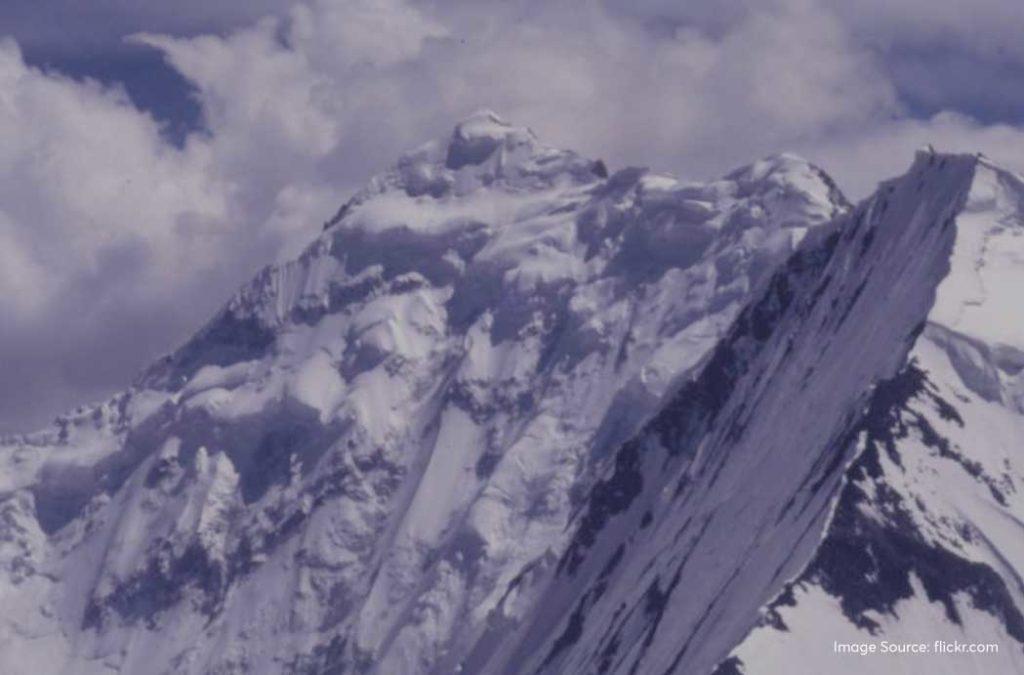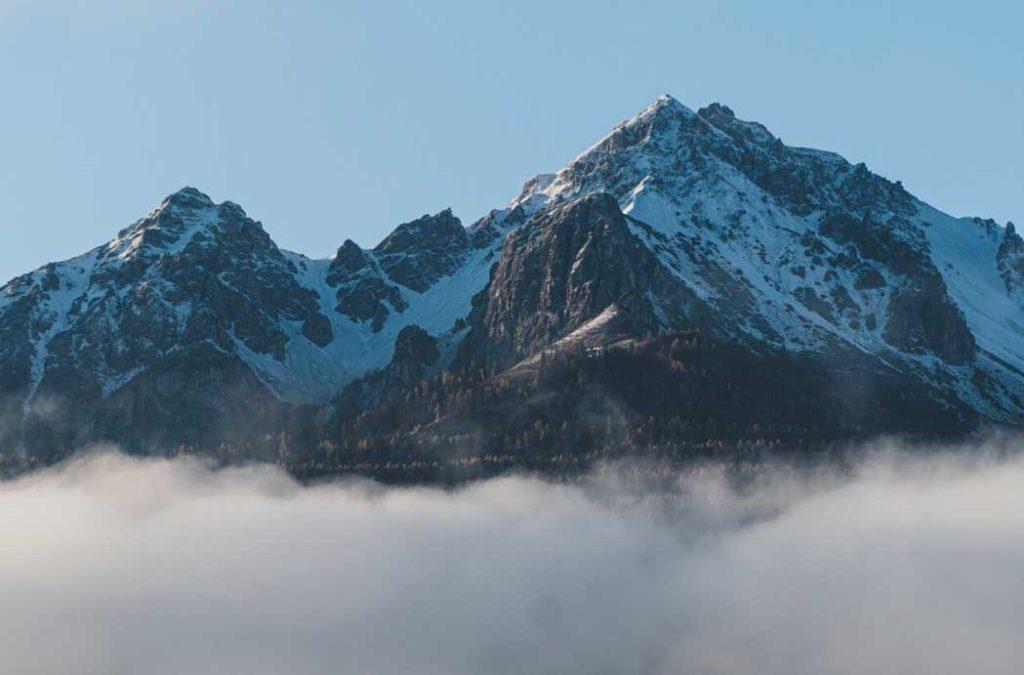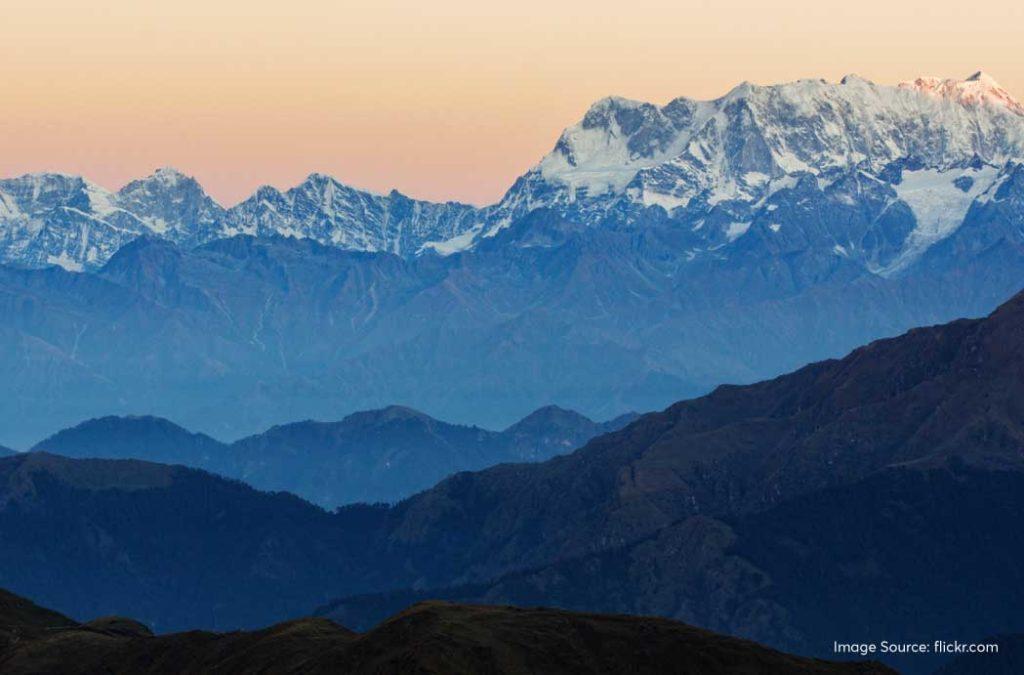The Peaks in India are so spectacular that once you lay eyes on them, you’ll stay completely starstruck and mesmerised. They cast an impressive shadow on the horizon, almost touching the unreachable skies. Their steep slopes have witnessed the tales of several mountain climbers. The rolling valleys cradle magnificent lakes and exotic flora and fauna. There are stories of wandering mythical creatures and hidden treasures too! But you can only hunt for the truth when you set out of your house to explore these 11 gorgeous peaks in India. They are the country’s pride, honour and undoubtedly the existing testimonies of the planet’s ancient forces.
Their sheer magnificence beckons adventure seekers toward them! If you are also planning to explore the tallest and most famous peaks in India, read on to find out more!
Also Read: THE MOUNTAIN CHRONICLES: BEST TIME TO VISIT SHIMLA FOR AN UNFORGETTABLE TRAVEL EXPERIENCE
The Most Sought-After Peaks in India
1 – K2

K2 is also known as Godwin-Austen Peak. It is a part of the Karakoram range and partly stands in the Pakistan-controlled region of Kashmir while some of it also comes under the jurisdiction of the Chinese who monitor the Trans-Karakoram Tract. Yet, it is considered to be one of the highest peaks in India and people are fascinated with its sheer existence. It is also called the ‘Savage Mountain’ because George Bell, a climber in 1953 described it as a savage mountain that tries to kill you! Approximately one person dies for every 4 people who try to climb this notoriously dangerous summit. Indians have to apply for a Visa if they want to see the portions of K2 that lie in the Pakistan and Chinese regions. While the number 2 represents the trigonometric aspects of the peak, K means Karakoram. The lesser Himalayas border K2 in the south and this is where you can get a clear glimpse of the peak. The melting glaciers from either side of the K2 peak are the main source of freshwater supply to regions in India, Pakistan and China.
Location: South to Lesser Himalayas in the Karakoram Range
Elevation: 8611 meters.
2 – Kanchenjunga

If not for the controversies surrounding K2, it would have been the highest peak in India. Kanchenjunga is just behind K2 and is currently considered to be the tallest one in India. Also popular as Khangchendzonga, it is the third-highest mountain peak in the world! It stands near the border of Nepal and India in the Greater Himalayan Range in the Sikkim region. The word Kanchenjunga means ‘The Five Treasures of the Snow’. The five treasures according to Indian beliefs are – Gold, Silver, Gems, Food Grains, and the Knowledge you gain from Holy Books. The main Kanchenjunga peak in India comprises five tall mountains, each representing one of the treasures. There are other smaller peaks too that have a height of 7000m. The people of Sikkim and Nepal consider this mountain sacred. So, even though people climbed this mountain, they refrained from reaching the peak seeing how the religious and spiritual heads wanted that part to be inviolate.
Location: Greater Himalayan Region in Sikkim
Elevation: 8586 meters
If you want to visit Kanchenjunga and are coming from other Indian states, you must make a pit stop in Gangtok. While you are at it, book your stay at Treebo Hotels in Gangtok for a comfortable experience.
3 – Nanda Devi

The Nanda Devi Peak is the second-highest mountain in India and is of great spiritual significance to the people of Sikkim and the Hindu community. Nanda Devi is believed to be the Goddess of happiness and prosperity. The people of Sikkim pray to Goddesses Nanda-Sunanda who are believed to be twins. Owing to religious sentiments, the government of India restricts mountaineers from climbing this peak. This peak, though not as tall as Kanchenjunga, stands on an elevation, thus giving an impression of being tall. It borders India and Nepal but is completely in the Indian region. The Nanda Devi National Park surrounds the peak and is home to several interesting fauna and beautiful flora. It was also declared a UNESCO World Heritage Site in 1988.
Location: Chamoli, Uttarakhand
Elevation: 7816 meters
4 – Kamet

Kamet is comparatively one of the less accessible peaks in India and the Himalayan region. It is surrounded by several other bigger peaks and stands very close to the Tibetan border. It is a part of the Zaskar Mountain Range in the Garhwal Himalayas. It is the highest peak in Garhwal and also has a rugged steep that is considered slippery and dangerous. Also, the plateau winds are rather strong and make mountaineers lose their grip. However, if the weather conditions are favourable, it is a rather straightforward ascent. In 1931, a group of Britishers climbed to the summit. There are 5 base camps that experts can rest in while climbing up. However, the last part of the climb comprises slippery snow so it is very challenging.
Location: Garhwal Region, Uttarakhand
Elevation: 7756 meters
5 – Saltoro Kangri

The Karakoram region is the biggest range in the Greater Himalayan Range. Saltoro Mountain range is part of Karakoram and Saltoro Kangri is the highest peak in this zone. Saltoro Kangri is at the centre of the Saltoro Range, so it is also very close to the biggest glacier in the world, the Siachen Glacier. It is also the 31st-highest independent peak in the world. Though there are two mountains – the Saltoro Kangri I and Saltoro Kangri II in the Saltoro Range, the tallest of the two, Saltoro Kangri I is usually referred to as Saltoro Kangri. This peak lies in the Actual Ground Position Line between India and Pakistan.
Location: Jammu and Kashmir
Elevation: 7742 meters
6 – Saser Kangri

The Saser Kangri is one of the highest peaks in India and also ranks as the 35th highest peak in the world. It is a part of the Karakoram mountain range and lies in the easternmost region. They are a group of five mountains that are connected to each other and the one at the centre appears tall and prominent. This one also happens to be the tallest peak in the Saser Muztagh region of Karakoram. The Sakang and Gukpoche glaciers are present on the northern side of this peak and they directly drain into the Nubra River. The eastern slopes of Saser Kangri drain into the North Shukpa Kunchang Glacier. Usually, the climbing attempts are made from the northern end of the peak, seeing how it is less steep, more populated and easily accessible from the Nubra Valley.
Location: Ladakh
Elevation: 7672 meters
7 – Mamostong Kangri

Some would also spell this as Mamostang Kangri. Mamostong Kangri is one of the highest peaks in India and the most sought-after one for mountain climbers. It is also the highest peak in the Rimo Mustagh sub-range of the Greater Karakoram range. This is another peak in India that is much closer to the biggest glacier in the world, Siachen Glacier. It is also popular as the 48th-highest independent peak in the world. What makes Mamostong Kangri all the more special is its straked, rugged beauty and distinct wilderness. It is underexplored except for the expert mountain enthusiasts. This isolated nature is what adds more allure to the mountain range and creates a sense of wilderness that some adore. The ones who manage to climb Mamostong Kangri will find the unique opportunity to witness the stunning landscapes surrounding the Indian Himalayas.
Location: Ladakh
Elevation: 7516 meters
Fascinated with the Himalayas? Trekking Enthusiasts May Also Like Reading: TRAVERSING THE TRIALS: THE 10 MOST GORGEOUS AND CAPTIVATING TREKS IN HIMACHAL PRADESH
8 – Rimo I

Rimo I is one of the tallest peaks in India and is a part of four peak massifs. All of them are named Rimo I to IV and Rimo I is the biggest of them, often referred to simply as Rimo Peak. It is a part of the Karakoram range in the Himalayan region. To the northeast of Rimo I, you will find the Karakoram range which is the biggest trading route in Central Asia and sees impressive business throughout the year. If you go 20km in the same northeast direction, you will arrive at the Siachen Glacier. The Rimo Glacier originates from this massif and drains into the Shyok River. Rimo means’ stripped mountain’ and that is exactly how this mountain range looks when you gaze at it from afar. The region near Shyok River is where you can make the base for stargazing. It is silent, secluded and absolutely stunning to look at the night sky when you are surrounded by nothing but the beauty of nature.
Location: Leh, Jammu and Kashmir
Elevation: 7385 meters
Interested in stargazing? Then You Must Definitely Read: TIME TO GET STARSTRUCK: HE MOST ALLURING LOCATIONS FOR STARGAZING IN INDIA
9 – Hardeol

Hardeol or Hardeul is one of the most fascinating peaks in India and the most famous one in the region. It is a part of the Kumaon region of the Milam Valley in the Garhwal Himalayan region. It is a remote area that is only explored by the locals and is known for its stunning natural beauty. People also call this the ‘Temple of God’ so climbing the summit is frowned upon. Also, it is steeper and has a challenging terrain in comparison to the other peaks in the Garhwal region. It is a part of the Nanda Devi Sanctuary region and guards the Nanda Devi Peak that we have discussed earlier in this article about peaks in India. People who are planning to visit this peak can also explore the traditional villages and monasteries that are generously scattered around Hardeol.
Location: Chamoli, Uttarakhand
Elevation: 7151 meters
10 – Trisul I

Trisul is one of the peaks in India that is closer to the Nanda Devi Sanctuary and is named after the powerful weapon of Lord Shiva – The Mighty Trishul or Trisul. This is because the three mountains resemble the three sharp spikes on the Trident that Lord Shiva holds in his hand. Trisul I is the tallest of the three mountain peaks that make up the Trisul massif in the western Kumaun region. It is also commonly called Trisul seeing how it is the highest and most prominent among all. The people look up to this mountain peak in the same way that they do with Nanda Devi Peak. However, you will be surprised to see how breathtakingly beautiful this peak looks during sunrise and sunset. The beam of sunlight reflects off the shiny surface of the snow and the place glistens like diamonds! You will also be surprised to know that this was the first of the 7000m and above peaks in India to have been climbed in 1907.
Location: Uttarakhand
Elevation: 7120 meters.
11 – Chaukhambha I

Chaukhambha I is a part of the Gangotri Group of mountains in the Garhwal Himalayan region. It is the tallest in the group and stands as the eastern anchor of the massif. This massif gets the name Chaukhambha, Chau meaning four and Khambha meaning pillars because the four mountains in the massif look like four pillars. Mana Pass is the most important pass in this region. Attempts to climb Chaukhamba remained unsuccessful until 1952, seeing how the terrain is challenging, and has dense snow coupled with strong winds.
Location: Gangotri, Uttarakhand
Elevation: 7138 meters
Not all of these highest peaks in India are accessible to commoners. But, they are all so great and striking that words can’t explain how marvellous they are. Though you cannot climb or go on treks, it is possible to see them from a distance and this itself can be quite overwhelming for nature lovers. It is something you will cherish for your entire lifetime. It is a treat for the eyes!
Whenever you find time, try to visit as many of these peaks as possible. You will definitely cherish the splendid experience.























